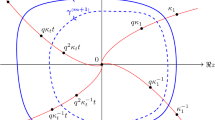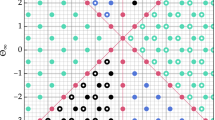Abstract
A Riemann-Hilbert problem for a q-difference Painlevé equation, known as \(q{\text {P}}_{{\text {IV}}}\), is shown to be solvable. This yields a bijective correspondence between the transcendental solutions of \(q{\text {P}}_{{\text {IV}}}\) and corresponding data on an associated q-monodromy surface. We also construct the moduli space of \(q{\text {P}}_{{\text {IV}}}\) explicitly.

Similar content being viewed by others
Notes
This equation has alternative names in the literature and is also referred to as \(q{\text {P}}_{{\text {IV}}}(A_5^{(1)})\), for its initial value space, or \(q{\text {P}}_{{\text {IV}}}\bigl ((A_2+A_1)^{(1)}\bigr )\), for its symmetry group – see [22].
References
Adams, C.R.: On the linear ordinary \(q\)-difference equation. Ann. Math. 30(1/4), 195–205 (1928)
Birkhoff, G.D.: The generalized Riemann problem for linear differential equations and the allied problems for linear difference and \(q\)-difference equations. Proc. Am. Acad. Arts Sci. 49, 521–568 (1913)
Borodin, A.: Isomonodromy transformations of linear systems of difference equations. Ann. Math. 2(160), 1141–1182 (2005)
Buckingham, R.: Large-degree asymptotics of rational Painlevé-IV functions associated to generalized Hermite polynomials. Int. Math. Res. Not. (2018)
Carmichael, R.D.: The general theory of linear \(q\)-difference equations. Am. J. Math. 34, 147–168 (1912)
Chekhov, L., Mazzocco, M., Rubtsov, V.: Quantised Painlevé monodromy manifolds, Sklyanin and Calabi-Yau algebras. Adv. Math. 376, 107442 (2021)
Chekhov, L., Mazzocco, M., Rubtsov, V.: Painlevé monodromy manifolds, decorated character varieties, and cluster algebras. Int. Math. Res. Not. IMRN 24, 7639–7691 (2017)
Deift, P.A.: Orthogonal polynomials and random matrices: a Riemann-Hilbert approach, 3, Courant Lecture Notes in Mathematics, New York University, Courant Institute of Mathematical Sciences, New York and American Mathematical Society, Providence, RI (1999)
Deift, P.A., Zhou, X.: A steepest descent method for oscillatory Riemann-Hilbert problems. Asymptotics for the MKdV equation. Ann. Math. 2(137), 295–368 (1993)
Fokas,A., Its, A., Kapaev, A., Novokshenov, A.: Painlevé transcendents, the Riemann-Hilbert approach. Math. Surv. Monograph. Am. Math. Soc. 128 (2006)
Fokas, A., Its, A., Kitaev, A.: Discrete Painlevé equations and their appearance in quantum gravity. Commun. Math. Phys. 142, 313–344 (1991)
Fokas, A., Muğan, U., Zhou, X.: On the solvability of Painlevé \({\rm I},\;{\rm III}\) and \({\rm V}\). Inverse Prob. 8, 757–785 (1992)
Gardner, C.S., Greene, J.M., Kruskal, M.D., Miura, R.M.: Method for solving the Korteweg-deVries equation. Phys. Rev. Lett. 19, 1095–1097 (1967)
Its, A.R., Kitaev, A.V., Fokas, A.S.: Matrix models of two-dimensional quantum gravity and isomonodromic solutions of “discrete Painlevé” equations. J. Math. Sci. 73, 415–429 (1995)
Its, A., Kitaev, A., Fokas, A.: An isomonodromy approach to the theory of two-dimensional quantum gravity. Uspekhi Mat. Nauk 45, 135–136 (1990)
Jimbo, M., Miwa, T., Mori, T., Sato, M.: Density matrix of an impenetrable Bose gas and the fifth Painlevé transcendent. Phys. D 1, 80–158 (1980)
Jimbo, M., Miwa, T.: Monodromy preserving deformation of linear ordinary differential equations with rational coefficients. II. Phys. D 2, 407–448 (1981)
Jimbo, M., Miwa, T.: Monodromy preserving deformation of linear ordinary differential equations with rational coefficients. III. Phys. D, 4, 26–46 (1981/82)
Jimbo, M., Miwa, T., Ueno, K.: Monodromy preserving deformation of linear ordinary differential equations with rational coefficients. I. General theory and \(\tau \)-function. Phys. D 2, 306–352 (1981)
Jimbo, M., Nagoya, H., Sakai, H.: CFT approach to the \(q\)-Painlevé VI equation. J. Integr. Syst. 2, (2017)
Jimbo, M., Sakai, H.: A \(q\)-analogue of the sixth Painlevé equation. Lett. Math. Phys. 38, 145–154 (1996)
Joshi, N.: Discrete Painlevé Equations. CBMS Regional Conference Series in Mathematics, 131. American Mathematical Society. Providence, Rhode Island (2019)
Joshi, N., Nakazono, N.: Lax pairs of discrete Painlevé equations: \((A_2+A_1)^{(1)}\) case. Proc. Roy Soc. A. 472, 20160696 (2016)
Joshi, N., Roffelsen, P.: Analytic solutions of \(q\)-\(P(A_1)\) near its critical points. Nonlinearity 29, 3696 (2016)
Kajiwara, K., Noumi, M., Yamada, Y.: Geometric aspects of Painlevé equations. J. Phys. A Math. Theor. 50, 073001 (2017)
Kapaev, A.A.: Global asymptotics of the fourth Painlevé transcendent. (1996), ftp://www.pdmi.ras.ru/pub/publicat/preprint/1996/06-96.ps.gz
Kapaev, A.A.: Connection formulae for degenerated asymptotic solutions of the fourth Painlevé equation. (1998), arXiv:solv-int/9805011 [nlin.SI]
Mano, T.: Asymptotic behaviour around a boundary point of the \(q\)-Painlevé VI equation and its connection problem. Nonlinearity 23, 1585–1608 (2010)
Masoero, D., Roffelsen, P.: Poles of Painlevé IV Rationals and their Distribution. SIGMA Symmetry Integrability Geom. Methods Appl., 14, Paper No. 002, 49, (2018)
Masoero, D., Roffelsen, P.: Roots of generalised Hermite polynomials when both parameters are large. ArXiv e-prints, arXiv:1907.08552, (2019)
Murata, M.: Lax forms of the \(q\)-Painlevé equations. J. Phys. A: Math. Theor. 42, 115201 (2009)
Ormerod, C.M., Witte, N.S., Forrester, P.J.: Connection preserving deformations and q-semi-classical orthogonal polynomials. Nonlinearity 24, 2405 (2011)
Rains, E.M.: An isomonodromy interpretation of the hypergeometric solution of the elliptic Painlevé equation (and generalizations). SIGMA Symmetry Integrability Geom. Methods Appl., 7, Paper 088, 24 (2011)
Ramis, J.P., Sauloy, J., Zhang, C.: Local analytic classification of \(q\)-difference equations. Astérisque 355 (2013)
Roffelsen, P.: On the global asymptotic analysis of a \(q\)-discrete Painlevé equation. PhD thesis, The University of Sydney, https://ses.library.usyd.edu.au/handle/2123/16601, (2017)
Sakai, H.: Rational surfaces associated with affine root systems and geometry of the Painlevé equations. Commun. Math. Phys. 220(1), 165–229 (2001)
Sauloy, J.: Galois theory of \(q\)-difference equations: the “analytical” approach. Differential equations and the Stokes phenomenon, pp. 277–292, World Sci. Publ., River Edge, NJ, (2002)
Shohat, J.: A differential equation for orthogonal polynomials. Duke Math. J. 5, 401–417 (1939)
van der Put, M., Singer,M.F.: Galois theory of difference equations. 1666, Lecture Notes in Mathematics. Springer, Berlin (1997)
van der Put, M., Saito, M.: Moduli spaces for linear differential equations and the Painlevé equations. Annales de l’Institut Fourier 59, 2611–2667 (2009)
Author information
Authors and Affiliations
Corresponding author
Additional information
Communicated by K. Johansson.
Publisher's Note
Springer Nature remains neutral with regard to jurisdictional claims in published maps and institutional affiliations.
N. Joshi: Her research was supported by an Australian Research Council Georgina Sweet Laureate Fellowship #FL120100094 and Discovery Projects #DP130100967 and #DP200100210.
P. Roffelsen: PR acknowledges the support of the H2020-MSCA-RISE-2017 PROJECT No. 778010 IPADEGAN.
Appendices
Appendix A: A Birational Transformation and Singularities
Define
then \(g=(g_1,g_2,g_3,g_4)\) satisfies the algebraic equations (2.9) and the rational inverse of (A.1) is given by
We denote the algebraic surface obtained by cutting \(\{g\in {\mathbb {C}}^4\}\) with respect to (2.9) by \({\mathcal {G}}(a)\). The f and g variables are bi-rationally equivalent, and in particular \(q{\text {P}}_{{\text {IV}}}(a)\) induces the time-evolution given by Eq. (2.10) on \({\mathcal {G}}(a)\).
While the forward iteration of Eq. (2.10) is singular on \({\mathcal {G}}(a)\), only when \(g_3=0\), we show its continuation is possible by means of singularity confinement. It is also possible to regularize these singularities by lifting to the initial value space \((A_2+A_1)^{(1)}\) following Sakai [36].
Namely, if \(g_3=0\), then \(\overline{g}\) and \(\overline{\overline{g}}\) do not exist whereas \(\overline{\overline{\overline{g}}}\) does and is given explicitly by
Similarly the inverse time-evolution is singular only when \(g_4=0\), in which case the first and second inverse iterates do not exist, whereas the third one does. We say that g(t) is singular at \(t_0\) when it does not exist at \(t=t_0\). The continuation formulae (A.3) of \(q{\text {P}}_{{\text {IV}}}^{\text {mod}}(a)\) can be obtained by means of direct calculation.
Considering the forward iteration, \(\overline{g}\) is ill-defined if and only if \(g_3=0\). So let us take any \(g^*\in {\mathcal {G}}(a)\) with \(g_3^*=0\) and perturb around it within \({\mathcal {G}}(a)\), setting
in particular \(g=g^*+{\mathcal {O}}(\epsilon )\), as \(\epsilon \rightarrow 0\). Then direct calculation gives
which diverges, as \(\epsilon \rightarrow 0\). Similarly
which diverges, as \(\epsilon \rightarrow 0\). However, upon calculating the third iteration, we find
which converges to (A.3), as \(\epsilon \rightarrow 0\). We conclude that the singularity is confined within three iterations. The singularity analysis of the inverse time evolution follows by similar arguments.
Appendix B: Cubic Surface Calculations
Recall the definition of the determinants \(\Delta _1\) and \(\Delta _2\) in Eqs. (5.9) and (5.1). Each of these determinants defines a cubic equation in the variables \(\rho _{1,2,3}^{x,y}\). The aim of this section is to show that these cubics are proportional to each other
and that they are proportional to the cubic defined in equation (2.16),
Firstly, we derive Eq. (B.1). To this end, let us note that we may alternatively write the functions \(v_{1,2,3}\) as
due to the symmetries (1.6) of the q-theta function.
Using these alternative expressions for \(v_{1,2,3}\) and expanding the difference of both sides of equation (B.1), i.e.
in terms of the variables \(\rho _{1,2,3}^{x,y}\), we find that all terms cancel except for
where
However, it follows directly from the symmetries (1.6) of the q-theta function that \(U_1=U_2\) and thus \(\Delta =0\), which proves equality (B.1).
Next, we derive Eq. (B.2). To this end, we first expand \(\Delta _2\) in terms of the variables \(\rho _{1,2,3}^{x,y}\), yielding the cubic
with coefficients \(\delta _0,\delta _1,\delta _2\) and \(\delta _3\) given by
\(\delta _{23},\delta _{13}\) and \(\delta _{12}\) given by
where
and the coefficient \(\delta _{123}\) given by
where
In order to derive Eq. (B.2), we factorise the functions \(h(\lambda ;z_1,z_2)\) and \(H(\lambda )\) into simple factors of q-theta functions. We start with \(h(\lambda ;z_1,z_2)\). Note that this function is an element of the vector space \(V_2(1)\), namely, it is analytic in \(\lambda \) on \({\mathbb {C}}^*\) and satisfies
Furthermore, it is easy to see that \(h(-1;z_1,z_2)=0\), hence, by Lemma 5.1,
for some yet to be determined coefficient \(c(z_1,z_2)\) which is independent of \(\lambda \). Then, by evaluating equation (B.4) at \(\lambda =1\), we obtain
and thus
We follow the same procedure to compute a factorisation of \(H(\lambda )\). We note that it is an element of the vector space \(V_3(-1)\), i.e. it is analytic on \({\mathbb {C}}^*\) and
Furthermore, it is easy to check by direct calculation that \(H(1)=H(-1)=0\), and hence
for some yet to be determined coefficient \(c_H\), which is independent of \(\lambda \). To determine this constant, we evaluate both sides of Eq. (B.6) at \(\lambda =x_1\). By means of analogous calculations as above, we can simplify \(H(x_1)\) to obtain
leading to
Now that we have explicit factorisations of the functions \(h(\lambda ;z_1,z_2)\) and \(H(\lambda )\) (respectively given by Eqs. (B.5) and (B.7)), and thus factorised expressions for the coefficients of the cubic (B.3), Eq. (B.2) follows immediately, upon using the symmetries (1.6) of the q-theta function.
Rights and permissions
About this article
Cite this article
Joshi, N., Roffelsen, P. On the Riemann-Hilbert Problem for a q-Difference Painlevé Equation. Commun. Math. Phys. 384, 549–585 (2021). https://doi.org/10.1007/s00220-021-04024-y
Received:
Accepted:
Published:
Issue Date:
DOI: https://doi.org/10.1007/s00220-021-04024-y




